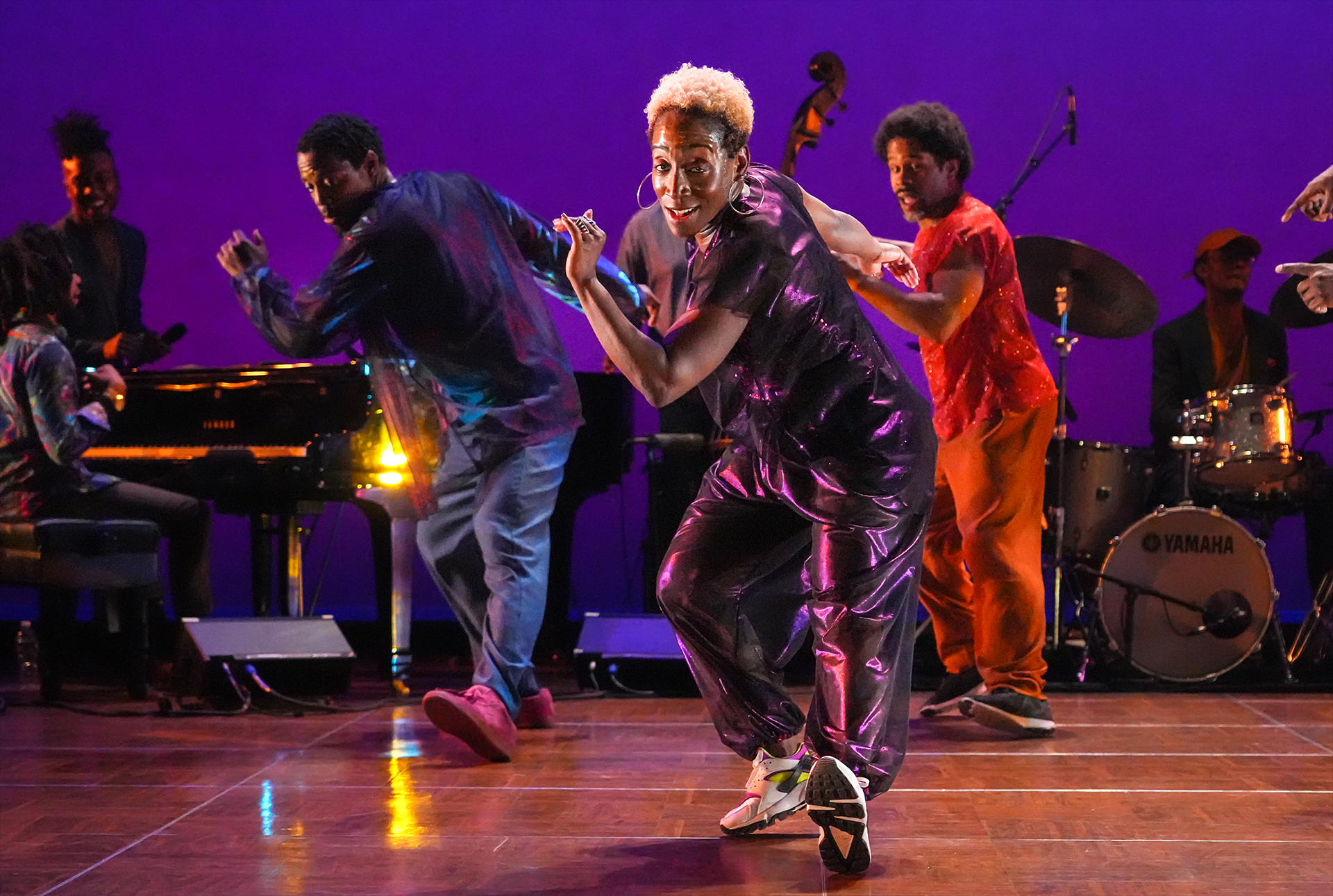In a review of LaTasha Barnes’s The Jazz Continuum on See Chicago Dance, Tristan Bruns describes this “communal celebration of Black American dance and music”:
Imagine a grey plate on a spinning platform being scored by dribbles of paint of different textures and colors—hot pink, orange, Kelly green, royal blue and mustard. Swirling. Combining. Splattered. Rising up? Yes! Nimble dancers emerge with time-altering powers. They dip in and out of the timestream, alive in multiple eras at the same moment. It’s a trip, a fantasy, an illusion… No!
It’s LaTasha Barnes’ “The Jazz Continuum,” a communal celebration of Black American dance and music running March 7-9 at the Dance Center of Columbia College Chicago. Timelines collide as different eras of jazz dance and adjacent forms—tap dance, footwork, popping, break dance, line dance and more—blend together in a seamless juxtaposition of styles.
DJ Porcia Lewis provides a hard-thumping, genre-bending soundtrack with live musical collaborators, the TJC Musical Explorers, led by Christopher McBride on saxophone and featuring vocalist Imani Rouselle
The way Barnes and company combine the dance styles of different eras is mesmerizing. Dance steps from the 19th and early 20th century, like The Stroll, The Tacky Annie and Suzie Qs, appear in the same breath as contemporary styles, like vogueing and locking, to create wonderful dance chimeras.
Famous jazz and pop standards receive an update. Dancers perform Leonard Reed’s hundred-year-old “Shim Sham” to a hip hop-infused rendition of Billy Strayhorn and Duke Ellington’s “Take the ‘A’ Train.” The swinging bounce of high-flying, back-flipping lindy hop partnering merges uncannily well with an augmented recording of Bill Withers’ “Harlem.” House, disco, R&B, soul, big band… All bend and fold with the dancing in an audible odyssey.
Recurring references date back to the origins of Black American dance. Several times the dancers form a cypher, grooving in a large circle with soloists improvising in the center, embodying the modern-day offspring of the Ring Shout, created by the enslaved Black dancers of the not-so-long ago American South. No matter how far they stray from each other, they repeatedly return to the circle, to the root.
Reminiscent of the “Soul Train Line,” the party parts several times, strolling into two columns between which soloists, duos and corps of dancers can strut their stuff, occasionally battling McBride and drummer Marcus E’Shadd Parker to an amicable standstill.
Impressive is how the entire company of “dance explorers” maintains a deep connection to the rhythm, pitch, dynamics, duration and timbre of the music. Guest dancer King Charles marches quickly on tip toe as McBride blows high-pitched, rapid-fire staccato bursts on the sax. Barnes in a solo matches the low-pitched beat by bassist Errick Lewis with low-centered b-girl finesse, with tap dance shuffles thrown in for good measure. Mighty blows from McBride’s sax send bodies flying in all directions as if hit by a cannon!
In a pre-show announcement, dramaturg and dancer Melanie “Auntie Legs” George tells us how the TJC Explorers are not just a dance company, but a family, and that “It’s not a show, it’s an offering.” And I believe her! The chemistry between the dancers is endearing. They lock eyes with each other. Sing to each other. Perform tiny skits more for their own amusement than for the audience.
With the same warmth they welcome to the stage “extended family” from Chicago, tap dancers Starinah “Star” Dixon, Donnetta “Lilbit” Jackson and footworker Charles “King Charles” Park, who incorporate into the program excerpts from Jackson’s 2022 piece, “A M.A.D.D. Mixtape.”
The constant flow of movement makes it hard to pin down any single part as a standalone piece, but that’s also the best part. The fluidity of form and bright-colored costumes are like a moving painting, a work of art best appreciated when taken in as a whole.
Spinning, blending, transforming… These are not just dancers and musicians but temporal pioneers, fearlessly exploring the universe of the jazz continuum.

